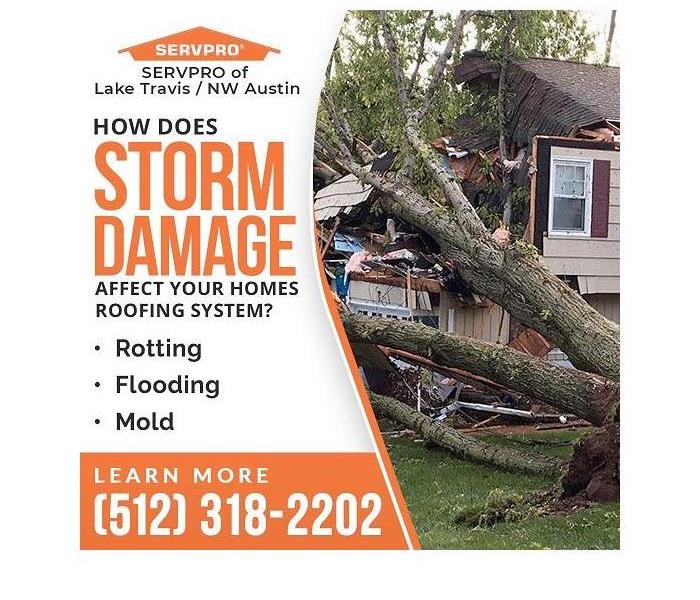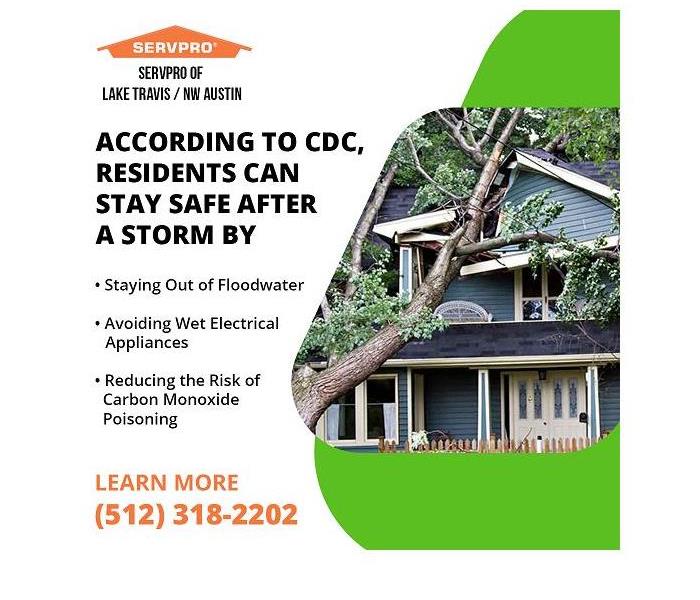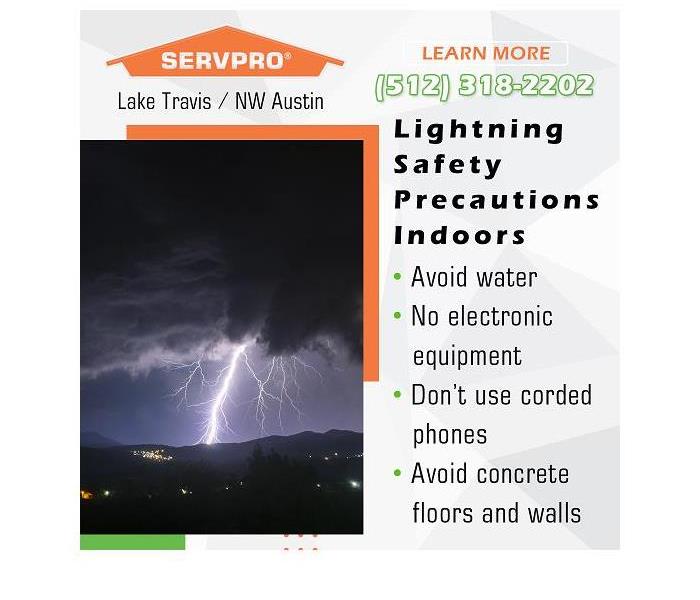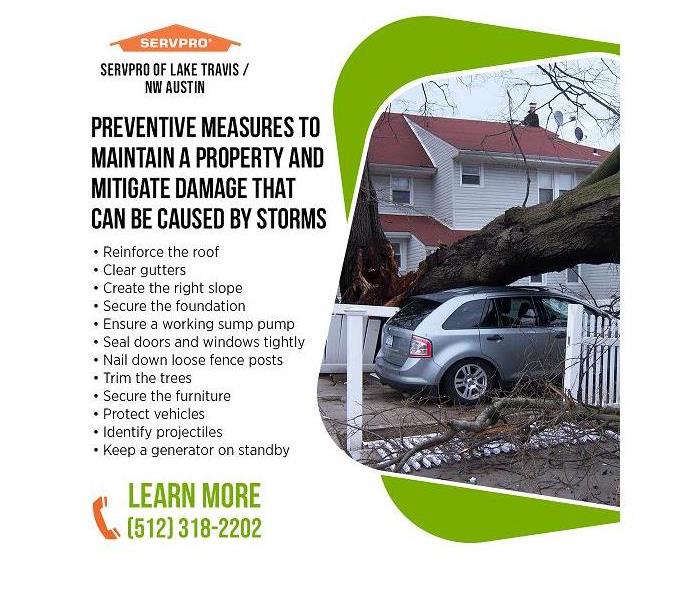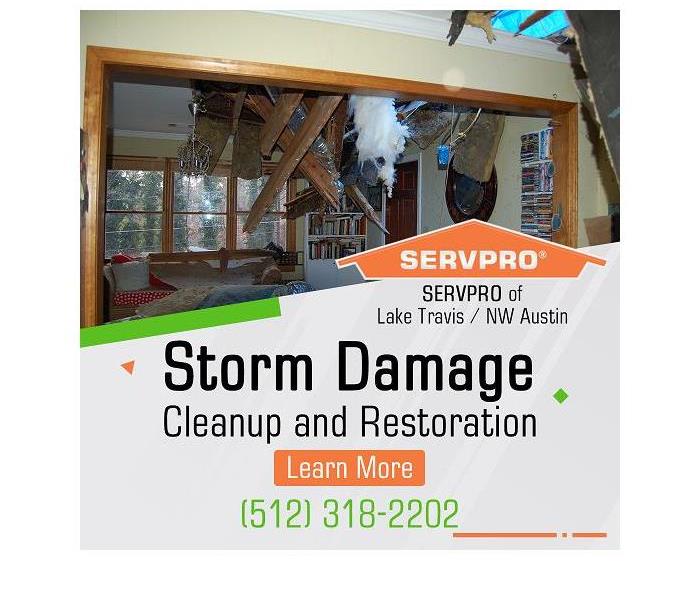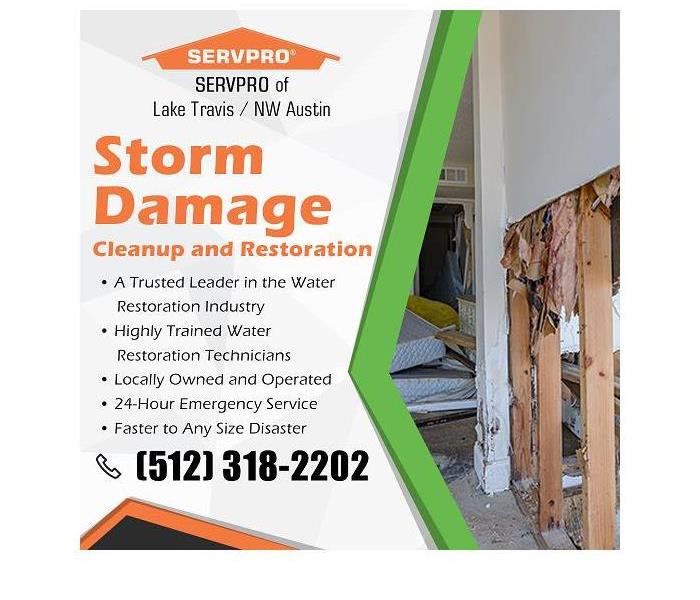Recent Storm Damage Posts
Inundation and its aftermath: The immediate impact that leaves no corner untouched.
1/5/2024 (Permalink)
 The back of a SERVPRO van heading to a job with the sign "Faster to any Disaster" on the back.
The back of a SERVPRO van heading to a job with the sign "Faster to any Disaster" on the back.
When a storm unleashes its full fury, the result is a powerful inundation that spares no corner of your greater Lake Travis/Lakeway area home. The rapid influx of water infiltrates every nook and cranny, leaving behind a trail of destruction. Water enters every crevice from the ground floor to the upper levels, leaving no area untouched.
As the water invades your living spaces, furniture, carpets, and belongings are soaked, bearing witness to the storm's force. Floors become slippery, making movement treacherous. Electrical systems are compromised, raising safety concerns. The immediate aftermath can leave you overwhelmed and confused.
Visible damage is only part of the story. Water seeps into hidden recesses and beneath floorboards, causing additional harm. Structural elements may weaken over time. Immediate action is crucial to prevent further deterioration and minimize long-term consequences. SERVPRO of Lake Travis/Lakeway recognizes the urgency of addressing the immediate impact of inundation. Our experienced team arrives swiftly, equipped with the tools and expertise to extract standing water and begin drying.
Call the experts at SERVPRO
In most cases, drywall can be dried within 3 to 5 days when drying equipment is placed by a restoration company. However, in some cases, the drywall will require removal due to certain circumstances during water damage.
- If drywall is affected by "grey or black water" that carries contaminates- The drywall will have to be removed and replaced. Examples of this type of water can be found here.
- If drywall has wet insulation in the wall cavities, the drywall and insulation will have to be removed and replaced.
- If drywall has double layers, the Drywall's layers will have to be removed and replaced.
- If drywall was not professionally dried and secondary damages occurred- The drywall will have to be removed and replaced.
Suffering from a water loss is never easy, but we are here to help minimize the impact it has on your family. Give your team at SERVPRO of Lake Travis/Lakeway today and let us handle all of your water and storm remediation needs for your home or office.
Commercial Roof Upkeep
9/30/2022 (Permalink)
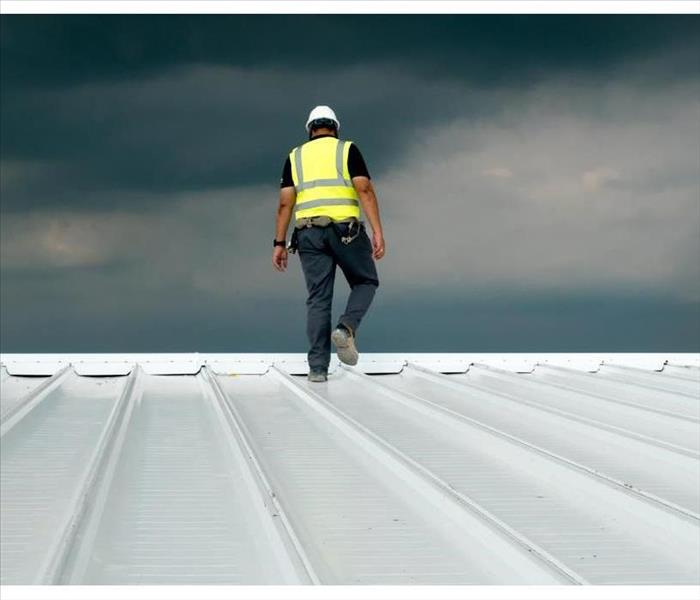 Commercial roof inspection
Commercial roof inspection
Commercial Roof Maintenance
If you are a Spicewood, TX, business owner, you probably take a lot of pride in maintaining your business. Protecting it against roof damage is one way that you can show others how much you care about your company. Here are some tips to remember to keep your proof in its best shape all year.
1. Consider waterproofing. There are several options for waterproofing materials that seal your roof and protect it from sunlight, rain and other causes of cracks. Many can be used without professional help and are fairly easy to apply.
2. Complete some landscape work. Trees and branches can lead to wind damage or damaging debris if they are hanging too far over the roof. You do not want to run the risk of a fallen tree damaging your business and causing safety hazards. Get professional landscaping help if needed to keep your plants safely trimmed.
3. Make inspections a regular routine. Your roof should be given a thorough inspection by whoever knows the most about it at least twice each year. Damaged drainage pipes, cracks and other roof damage red flags should be addressed as soon as possible in order to avoid a complete roof rebuild.
4. Know where to get help. If the worst case scenario occurs and you are left with damage in the aftermath of a Spicewood, TX, storm, local commercial storm damage restoration specialists should be able to help you figure out a cleanup and repair plan to get your business back in the shape it was before the bad weather hit. If you need immediate help, there are many teams that are available to arrive on a 24/7 basis for emergency cleaning.
No one wants to think about the bad things that could happen to their commercial building, but taking care of your property before something urgent occurs can help you prevent any excessive roof damage from occurring in the future.
How To Fix a Sewage Backup in Your Bathtub
8/23/2022 (Permalink)
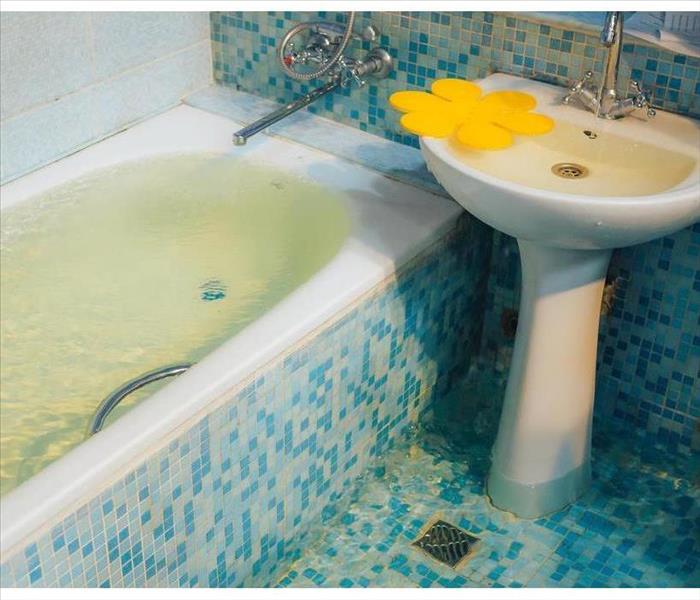 A sewer backup can damage your home if left unattended.
A sewer backup can damage your home if left unattended.
How to Address a Bathtub Sewage Backup
It’s a problem you as a homeowner in Spicewood, TX, never want to face – sewer backup into your shower or bathtub. How does it happen? You may flush your toilet one day and notice the drain is slower than normal and then the next time you flush, the waste and water suddenly appear in your bathtub. Since the problem is hidden deep inside your plumbing pipes, you may not know how to handle the situation. Here are four helpful hints.
1. Assess the Situation
Turn the water valve to the toilet off to ensure it doesn’t get flushed again. Then, although it sounds unpleasant, look to see what type of bathtub backup has blown up through the pipes with the sewage. Check for dirt, rocks, or plant roots because it could mean a broken sewer line in addition to a clogged line.
2. Contact a Professional
You may be tempted to try and fix the sewer backup with the help of a plunger, but if the clog is serious enough to completely block the line, you probably need the advice of a water mitigation technician. He or she has access to tools such as cameras and line-snakes that can often open the blocked line quickly to prevent further flooding.
3. Clean the Area
Once the line is open, and the water is running free, the water specialist can begin cleaning the area to remove the residue that is still inside the bathtub after the liquid drained back out. Most experts use the help of a specially designed vacuum.
4. Disinfect the Tub
The last step in the sewage cleanup process is generally to disinfect the area to keep your family safe. The technician knows which cleaner and disinfectant to use in the cleanup to fight the bacteria and germs associated with sewage problems.
A sewer backup can damage your home if left unattended. However, with the help of a water technician, the situation can quickly be remedied.
Storms: Prepare Your Home
7/30/2022 (Permalink)
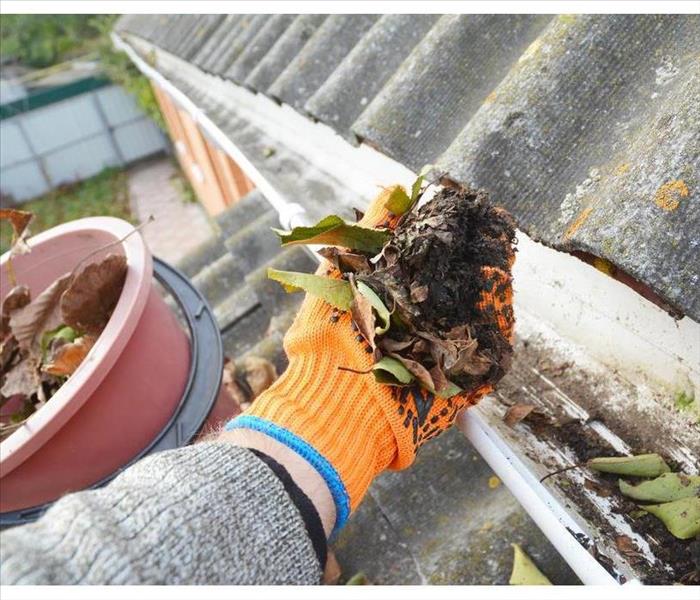 Keep your gutters and drains clean.
Keep your gutters and drains clean.
Storm Preparedness
Are you worried about the damage that flood water from an Anderson Mill, TX, storm could cause to your house? There are a few actions that you can take to defend your home against these powerful weather events:
1. Install a sump pump. A battery-operated model is ideal, as it can be used during power outages. A sump pump can be a very good defense against excess water that can lead to a flooded building.
2. Get flood insurance. Did you know that your homeowner’s insurance policy does not cover floods? If you do not already have flood insurance, now is the time to consider purchasing it. If you have forgotten to renew your policy, you will want to do so before a storm hits.
3. Use check valves. Installing check valves around your house can be a relatively simple way to prevent flood water from becoming an issue. They prevent reverse water flow and are automatic, so you do not have to operate them by hand in order to prevent flooding.
4. Clean gutters and drains. Many homeowners forget to clean their drains and gutters, which can lead to water backup outside and inside your home. Complete regular inspections and clean any buildup that you find. Scheduling periodic checks can help you keep your home in the best shape to prevent floods year-round.
Remember that no matter how hard you try to protect your home, there is still always a possibility of storm-related destruction. Fortunately, water damage restoration specialists in the Anderson Mill, TX, area can usually arrive on the scene - often on a 24-hour emergency basis - and survey any damage from flood water that has occurred. They can also put together and typically initiate a cleanup plan that will give you the best chances of restoring your property and possibly even salvaging your water-logged belongings. Storms are scary, and damage from them is even scarier. Help ease your own mind by planning ahead and knowing where to turn for help if it should be needed.
How Does Storm Damage Affect Your Home’s Roofing System?
11/18/2021 (Permalink)
Blog Summary: SERVPRO of Lake Travis and Northwest Austin area describes three ways storm damage impacts a roofing system and four indications that repairs are needed.
SERVPRO specializes in cleanup and restoration after a fire, storm, flood, and other incidents affect a home or commercial space. Serving the Lake Travis and Northwest Austin area, their experienced team members make repairs associated with mold, smoke, sewage, vandalism, fires, storm damage, and more. Services include odor removal, deep cleaning, mold remediation, and complete renovation.
The staff at SERVPRO must undergo intensive preparation before being assigned to a project. They must meet the highest IICRC standards, complete employee certification training, take an initial franchise course, participate in ongoing web-based workshops, and attend a selection of continuing education classes. Their 24/7 emergency services offer peace of mind to residents who may need storm damage restoration at odd times of the day or night. SERVPRO’s exceptional team restores home roofing systems with precision and care, returning them to their original glory.
How Does Storm Damage Affect Your Homes Roofing System?
#1: Rotting
Strong winds can blow shingles off roofs, allowing water to seep into areas and cause havoc. Cracked or broken shingles are especially susceptible to high winds and are more likely to go missing. It only takes two missing roof shingles for water damage to begin. Over time rotting will occur, leading to roof leaks that require extensive water cleanup.
#2: Flooding
While rotting will eventually lead to flooding, falling trees, hail, or heavy rain can cause water damage within just a few hours. Water can find its way into your home through holes in the roof, cracks in the foundation, or broken windows. Depending on how severe the damage is, this may call for emergency water restoration.
#3: Mold
Storm damage restoration often includes mold removal. Anytime there is flooding in a home, mold is likely present and will only spread if it’s not properly handled. It’s best to research local mold remediation companies and hire trained professionals to treat and remove the mold before it gets out of control.
Signs Your Home Is in Need of Storm Damage Restoration
#1: Fallen Shingles
One of the most obvious signs of roof damage is fallen shingles. Search the yard, street, and nearby trees for them after a big storm. Also, examine the roof for areas where parts of the surface appear to be missing.
#2: Puddles in the Attic
When water damage isn’t immediately obvious, the attic can offer some answers. If there is flooding, the attic is the first place it will appear. Check for puddles and damp spots for leaks to see if water damage restoration is necessary.
#3: Water Dripping Down Walls
More severe water damage will cause flooding in your living spaces. After a severe storm, check for water stains on the ceiling or dripping down the walls. These may take some time to appear and may not be noticeable right away.
#4: Broken Shingles
Heavy rain and hail can dent or break shingles, leaving the roof susceptible to water damage. Water restoration companies can examine roof shingles and determine whether any shingles need to be replaced or if storm damage restoration is required.
SERVPRO serves over a dozen cities around Austin, Texas, including Leander, TX, River Place, and Canyon Creek. If you need storm damage restoration services, call them now at (512) 318-2202 to schedule an appointment.
Four Important Things to Do While Waiting for a Storm Damage Restoration Contractor
9/22/2021 (Permalink)
Blog Summary: The professionals at SERVPRO go over the most important steps to take while waiting for a storm damage restoration to arrive.
With climate change making the weather increasingly unpredictable, it pays to know what to do if a storm is on the way and how to stay safe and minimize property damage after the storm hits. The experts at SERVPRO of Lake Travis / NW Austin, a leading storm damage restoration company, recommend homeowners take four simple steps before their cleanup crew arrives.
Four Important Things to Do While Waiting for a Storm Damage Restoration Contractor
1. Safety First
According to the Centers for Disease Control and Prevention (CDC), residents can stay safe after a storm by:
- Staying Out of Floodwater: Floodwater can carry various harmful germs and chemicals. If these contaminants enter the bloodstream, it could lead to serious illness, which is the last thing anyone needs while recovering from property damage caused by a storm.
- Avoiding Wet Electrical Appliances: If the storm has led to indoor flooding, turn off the power at the main breaker. Water touching live electrical appliances or connections may lead to electrocution or fires. Likewise, when outside, stay away from fallen power cables and poles.
- Reducing the Risk of Carbon Monoxide Poisoning: If using a generator for power during a storm, ensure that the unit’s exhaust system is facing outdoors. Carbon monoxide from exhaust fumes can cause sudden illness and even death in an enclosed space. Additionally, only use charcoal grills, camp stoves, and similar carbon monoxide-producing equipment in well-ventilated spaces.
Calling an emergency water restoration team like SERVPRO will ensure that the water cleanup and restoration process gets started as soon as possible after a storm. Quickly getting rid of indoor flood water will reduce the risk of long-term water damage and flood-related injuries.
2. Check the Sump Pump
If there is a sump pump in the building, verify that it’s working and removing floodwater. The sooner any water is removed from the property, the lower the chance of secondary damage, such as mold. Many mold remediation companies report growth can start in as little as 24 hours.
3. Photograph the Damage
While waiting for the storm and water damage restoration company to arrive, take pictures of any damage. These pictures will serve as evidence during the insurance claim process and are often crucial to prove the cause of the water damage.
Beyond photographs, it’s also best to keep other forms of evidence, such as receipts for hotel costs and water and mold removal services. If you choose SERVPRO for your residential or commercial water damage restoration, they can handle the claim process.
4. Avoid Additional Property Damage
If it looks like the storm may resume, boarding up broken windows can help prevent additional damage. This step will also minimize heat loss and secures the property during the restoration process. Residential or commercial cleaning services generally take at least 24-hours.
About SERVPRO of Lake Travis / NW Austin
SERVPRO of Lake Travis / NW Austin is among the top fire, water, and storm restoration companies in Spicewood, TX. They are a fully licensed, full-service contractor offering 24-hour emergency storm restoration services with fast response times.
From mold remediation to biohazards, SERVPRO can handle all manner of residential and commercial cleanup projects. Follow them on Facebook, or call the office at (512) 318-2202, located in Austin, TX 78730 to learn more.
Flash flooding and its impact
8/24/2021 (Permalink)
Blog summary: The SERVPRO blog educates homeowners about flash flooding and its impact.
All about flash flooding
Flash flooding can wreak havoc on unsuspecting residents in a matter of hours. But a basic understanding of flash flooding can help homeowners prepare better for the eventuality. SERVPRO of Lake Travis / NW Austin, a storm damage restoration service, discusses flash flooding and its impact in detail below.
What is Flash Flooding?
Flash floods can be caused by heavy rainfall during thunderstorms or breaks in dams or levees and/or mudslides. It is defined as a flood that occurs within 6 hours of heavy rainfall or other reasons, but it can occur in as little as a few minutes as well. It is usually quite dangerous as it combines a flood’s normal potential with unpredictability and a wildly rapid timeframe.
What causes flash flooding?
Here are a few factors that determine the swiftness and location of flash flooding:
- Intensity of rainfall
- Location and distribution of rainfall
- Land use and topography
- Vegetation type and growth/density
- Soil type
- Soil water content
Despite these factors, urban areas are more susceptible to flash flooding than others due to the presence of buildings and concrete. The capacity of the soil to absorb water in these areas is much lower than in other areas.
Regions near rivers or large streams are also at an increased risk. If the flow of water drastically changes from upstream, it can cause the river or body of water to expand to dry land, resulting in a flash flood. Ravines and mountains face similar scenarios.
The FEMA (Federal Emergency Management Agency) flood map helps determine an area’s risk for flooding. Flood insurance is determined by the location of the property in a flood-risk zone. A flood insurance policy from the National Flood Insurance Program (NFIP) marks the difference between recovery and a devastating financial loss.
The Impact of flash flooding
Death or Injury
The unpredictable nature of flash floods makes them very dangerous. Due to the lack of warning, many people get injured or killed by these floods. Often these flash floods occur at night while people are sleeping. According to the National Weather Service, flash floods are the biggest cause of weather-related deaths in the US.
Instant Property Damage
With the combination of the force of water and the large debris that flash floods carry, the amount of structural damage can be immense. The damage caused to homes can make them uninhabitable and disrupt lives.
Irreversible Property Damage
Rooms, vehicles, and other contents that came in the path of floodwaters may not be salvageable. Homes become susceptible to harmful molds. Submerged vehicles bear irreparable water damage to the engine and other critical components.
Loss of Infrastructure
Structural damage to bridges and roadways makes travel impossible. Power, telephone, and cable lines may be damaged by flash floods. The contaminated floodwaters pollute groundwater and make tap water unfit for consumption.
Sediment & Silt
Floodwaters carry sand, silt, and other debris with them as they travel. When the velocity of the flash flood slows, it begins depositing this debris that can make travel difficult. Removing this debris is another huge expense.
Uninsured or Under-insured Homeowners
Since the usual homeowner’s insurance doesn’t cover flood damage, many homeowners experience huge financial losses. Homeowners must figure out if their property lies in a flood-risk zone and must get flood insurance through the NFIP.
- Business Loss
Flash floods usually wreak havoc on homes and businesses alike. The extent of the damage may delay the recovery process and therefore cause further losses to business owners.
Just one inch of floodwater can cost $25,000 in damages. Poor drainage systems, neighborhood construction, and broken water mains can also cause flooding or exacerbate the flash flood caused by rainfalls. Flash floods cannot be controlled or stopped, but homeowners can educate themselves, and be prepared in case of this natural calamity.
When the storm is over, SERVPRO’s storm damage restoration team can help restore and rebuild properties, and help homeowners return to their lives as swiftly and smoothly as possible.
Why SERVPRO?
- SERVPRO uses state-of-the-art equipment to bring the damaged property back to its original state. SERVPRO of Lake Travis/NW Austin is always updating its fleet and equipment so clients in Lake Travis/NW Austin, or anywhere else can quickly access the services.
- With over 1,700 US and Canadian Franchise locations, SERVPRO is strategically positioned to respond faster to an emergency of any magnitude.
- The SERVPRO staff is highly trained in property damage restoration. They receive initial in-house training and constant skill up-gradation at the corporate training facility and also acquire the regular IICRC-industry certification.
For storm damage restoration services in Spicewood and surrounding areas, call SERVPRO of Lake Travis/NW Austin today at (512) 318-2202.
SERVPRO: How to Protect Against Lightning Strikes?
7/21/2021 (Permalink)
Blog summary: The article by SERVPRO states facts about lightning and suggests several lightning safety tips.
Lightning facts and safety tips
Lightning kills as many as 2,000 people worldwide, every year. Hundreds of people get struck but survive, usually with lingering and debilitating symptoms. Although the odds of being struck by lightning in a year are less than 1 in a million, some factors can put individuals at greater risk. Lightning usually strikes people who work outside or engage in outdoor recreational activities. SERVPRO, a storm damage restoration company, shares important facts about lightning and some safety tips.
Facts about lightning
- All thunderstorms produce lightning and are dangerous.
- Lightning often strikes outside the area of heavy rain, as far as 10 miles beyond.
- Many lightning deaths occur before and after the storms.
- If one can hear thunder, lightning is an imminent threat.
- Lightning leaves many victims with permanent disabilities. Only about 10% of lightning victims die whereas many survivors struggle with intense pain, neurological disabilities, depression, and other health effects.
Lightning safety precautions outdoors
When outside, the following precautions must be taken to protect from lightning:
- Listen to the forecast: Avoid stepping out in the first place. If there is a prediction of a thunderstorm or lightning, postpone the trip or outdoor activity. Stay home.
- Thunder means danger: If thunder can be heard, it is close by. Find a safe, enclosed shelter such as homes, offices, shopping centers, and hard-top vehicles with the windows rolled up.
- Follow the 30-30 rule: Once lightning is sighted, count till 30. If it thunders before the count of 30, go indoors. After the last clap of thunder, suspend all activities and stay indoors for at least 30 minutes.
- No tents: Most modern tents have carbon fiber or metal poles. They can become a grounding path for a cloud-to-ground lightning strike.
- In case of no shelter: Crouching can reduce the chances of being struck but does not eliminate all danger. Here are few steps to take when there is no safe shelter nearby:
- Climb down: Immediately get off elevated areas such as hills, mountain ridges, or peaks. Never take shelter under a cliff or rocky overhang. Find a low-lying place such as a ravine or a valley, but beware of flash floods.
- Baseball catcher’s position: Crouch down in a baseball catcher’s position, with heels on the ground, ears covered, and head between the knees. Ensure minimal contact with the ground. Never lie flat on the ground.
- Thick forest: Never shelter under an isolated tree. Find a low area under a thick growth of small trees.
- Steer clear of water: Immediately move away from ponds, lakes, and other bodies of water.
- Stay away from conductors: Objects that conduct electricity (such as barbed wire fences, power lines, or windmills) must be avoided.
- No concrete: Stay away from concrete floors or walls as lightning can travel through any metal wires or bars in concrete walls or flooring.
Lightning safety precautions indoors
Being indoors is safer than being outdoors during a thunderstorm. But statistically, about one-third of lightning-strike injuries occur indoors. Follow the tips below to keep safe from lightning while indoors:
- Avoid water: Do not bathe, shower, wash dishes, or have any other contact with water during a thunderstorm. Water, as well as plumbing pipes, are good conductors of electricity.
- No electronic equipment: Lightning can strike through electrical systems, radio, and television reception systems. Don’t plug or unplug electrical equipment during the storms.
- Don’t use corded phones: Avoid using corded phones during a thunderstorm. Instead, opt for cordless or cellular phones.
- Avoid concrete floors and walls: Lightning can travel through metal wires or bars in concrete walls or flooring. Therefore, do not lie on concrete floors during a thunderstorm.
Follow these precautions to avoid being struck by lightning. If a person is struck by lightning, call 911 and get medical help right away. For storm damage restoration services, call a professional team such as SERVPRO right away.
Why SERVPRO?
- SERVPRO uses state-of-the-art equipment to bring the damaged property back to its original state. SERVPRO of Lake Travis / NW Austin is always updating its fleet and equipment so clients in Lake Travis / NW Austin, or anywhere else can quickly access the services.
- With over 1,700 US and Canadian Franchise locations, SERVPRO is strategically positioned to respond faster to an emergency of any magnitude.
- The SERVPRO staff is highly trained in property damage restoration. They receive initial in-house training and constant skill up-gradation at the corporate training facility and also acquire the regular IICRC-industry certification.
For storm damage restoration services in Leander and surrounding areas, call SERVPRO of Lake Travis/NW Austin today at (512) 318-2202.
12 preventive measures that can reduce the damage caused by storms
5/24/2021 (Permalink)
Blog summary: SERVPRO talks about 12 ways to strengthen a property to reduce storm damage and how SERVPRO technicians can help.
How to mitigate storm damage?
Storms are unpredictable and the damage they can cause can be extensive and life-threatening. SERVPRO shares 12 preventive measures to maintain a property and mitigate damage that can be caused by storms.
- Reinforce the roof
A roof that is 5-10 years older should be checked for damaged shingles and loose nails and sheathing.
- A damaged shingle is more likely to break free during a storm. And a missing shingle is a dangerous gap for the wind to get under and cause more damage. Ensure the shingles are installed correctly - not above the nail line.
- The siding must also be checked for damage and repaired as per need.
- The chimney flashing must be in prime condition and the chimney can be tightly sealed, if necessary.
- Reinforce the roof by having it retrofitted with brackets, bracing, clips, or straps.
The SERVPRO roof restoration team can assist in repairing and reinforcing the roof and making the property safer during storms.
- Clear gutters
Ensuring the gutters are clear is the first line of defense in helping water to flow away from the property. Gutters should be free-flowing and the downspouts must flow away from the foundation.
In case there is water damage after a storm, SERVPRO water damage technicians can help the owners restore their property.
- Create the right slope
The grade of the lot should allow water to flow away from the property and into a ditch, drain, or any proper retention area. One could add some soil to create a slope of a quarter-inch per foot heading downhill away from the property’s foundation. Gravity will pull the water away from the house and prevent summer storm damage.
- Secure the foundation
To avoid basement flooding and water damage to property during a storm, the house foundations should be completely waterproof. Necessary repairs must be made to any cracks:
- Small cracks must be sealed with caulk designed to repair masonry
- Larger gaps should be mended with hydraulic cement
- Ensure a working sump pump
Sump pumps must be checked before spring rains start. To be extra safe, a backup sump pump along with a battery backup, in case of power cuts, would help safeguard against basement flooding.
- Seal doors and windows tightly
In case of tornado winds, a small opening in windows or doors could enlarge and allow enough wind inside to compromise the property’s roof.
- Check doors for missing screws/bolts or loose hinges
- Fit keyhole covers on doors to keep rainwater and snow at bay
- Use weather-stripping to seal doors and windows tightly
- Apply caulk on both sides of windows to prevent water seepage
- Apply a durable clear plastic film on windows to prevent glass shards from blowing inside the house if the winds breach the windows
- Install permanent shutters to shield windows from wind and debris
- Windows made especially to withstand storm-level air pressure and impact can be installed in areas with extreme weather conditions
- Nail down loose fence posts
Fence posts that are not nailed down will be uprooted by storm winds. Therefore, they must be checked during the storm preparation.
- Trim the trees
A dead, hollowed, or diseased tree is unlikely to stand up to the strong winds and rains of a summer storm. Such problem trees can damage homes, vehicles, or even a neighbor’s property. A tree expert can also be hired to check for dangerous trees.
In general, regularly trimming the trees on the property is an excellent way to protect the roof and windows.
- Secure the furniture
Heavy, tall furniture, such as bookshelves or cabinets, should be anchored to the wall so they’re secure and won’t fall. Additionally, furniture must be moved away from doors or windows.
- Protect vehicles
Vehicles left outdoors during a storm are bound to be impacted by flying debris and hail. They can be parked in the garage, a covered parking space, or a temporary shelter.
- Identify projectiles
Items such as lawn furniture, tools, grills, picnic tables, and flower pots must be moved indoors to a garage or shed, lest they become dangerous projectiles.
- Keep a generator on standby
A power cut-off, for some hours or even days, is a likely incident in case of a bad storm. So it is advisable to have a generator at hand so living in the house is comfortable until power is restored.
Why SERVPRO?
- SERVPRO uses state-of-the-art equipment to bring the damaged property back to its original state. SERVPRO of Lake Travis / NW Austin is always updating its fleet and equipment so clients in Lake Travis / NW Austin, or anywhere else can quickly access the services.
- With over 1,700 US and Canadian Franchise locations, SERVPRO is strategically positioned to respond faster to an emergency of any magnitude.
- The SERVPRO staff is highly trained in property damage restoration. They receive initial in-house training and constant skill up-gradation at the corporate training facility and also acquire the regular IICRC-industry certification.
For storm damage restoration in Leander and surrounding areas, call SERVPRO of Lake Travis / NW Austin today at (512) 318-2200.
4 Common Myths about Storm Restoration Debunked
3/11/2021 (Permalink)
Blog Summary: The experts at SERVPRO of Lake Travis / NW Austin reveal the truth about storm damage and the storm damage restoration process to debunk four common myths.
Homeowners in the Austin area are no strangers to storms, but a few storm damage restoration myths persist in the area nonetheless. Misconceptions about storm damage restoration can lead to further damage and unnecessary costs—the experts at SERVPRO of Lake Travis / NW Austin, TX, are here to debunk these myths and reveal the truth.
They have restored countless storm-damaged homes and are committed to helping the good people of Austin understand types of storm damage and the restoration process.
4 Common Storm Restoration Myths Debunked
#1: If There Isn’t Visible Damage, There is No Damage
A visual inspection is the first step in assessing storm damage, but it’s a mistake to assume a roof or any other part of a home is unharmed just because there are no visible issues.
Small cracks, dents, or punctures may go unnoticed, but they can still let water into the home or grow worse over time. After a storm, it is important to have a storm damage restoration expert who understands common signs of storm damage perform a complete inspection. This allows them to document the damage properly for insurance purposes.
# 2: Warranties Cover All Roof Damage
Unfortunately, even homeowners with brand new roofing systems cannot rely on their warranties to cover all types of storm damage. Many roof warranties explicitly exclude storm and hail damage, as neither is directly related to the materials or installation process.
If a warranty does cover storm damage, getting an inspection and beginning repairs quickly is vital. Failing to address issues promptly may result in more damage, which the warranty would not cover as it was caused by a failure to act.
#3: Water Removal is Enough to Prevent Mold Growth
Water damage is common following a major storm, whether from roof damage, a broken window, or a burst pipe. While removing any standing water from the area is an excellent first step—it should never be the last step to avoid mold growth.
Any waterlogged building materials, such as sheetrock, need to be dried or replaced if necessary, and efforts should be made to bring the humidity level back to a safe level.
#4: Not Filing a Claim Is an Effective Way to Avoid Rate Increases
Even if a homeowner does not file a claim for storm damage, their insurance rate may increase. As other homeowners in the area will be filing claims, all homeowners in the area will see a rate increase, whether they file a claim or not.
However, in situations where the cost of storm damage restoration would not exceed the deductible on the policy, avoiding the claims process may make sense. Hiring a storm damage restoration company to assess the damage is the first step in either case.
About SERVPRO
SERVPRO has served the Lake Travis and Leander, TX, area for more than 30 years. They offer a wide range of storm damage restoration services, such as water cleanup and mold remediation. Their team works to make getting back to everyday life after a storm as hassle-free as possible.
For more information about storm damage or the restoration process, contact their team at (512) 318-2202.
Contact Information:
SERVPRO of Lake Travis / NW Austin
6500 River Place Boulevard
Building 7 – Suite 250
Austin, TX 78730
www.SERVPROlaketravisnwaustin.com/
4 Steps to Take After Storm Damage: A Guide for Homeowners
1/26/2021 (Permalink)
Blog Summary: If your home experiences storm damage, you might not know how to bring your property back to its pre-storm condition. SERVPRO of Lake Travis/NW Austin provides a helpful guide for homeowners dealing with storm damage.
4 Steps to Take After Storm Damage: A Guide for Homeowners
After a storm, you might be shocked to see how much damage is left in its wake. Water and wind can affect everything from your roof to the trees in your yard—sometimes even flooding your house.
Dealing with the aftermath of a severe storm can be distressing, but the professionals at SERVPRO of Lake Travis/NW Austin, one of the area’s leading storm damage and emergency water restoration companies, are here to help. Below, they offer a simple guide to help you manage your property after inclement weather strikes.
Assess the Damage
Once the storm leaves the area and it's safe to go outside, it's time to evaluate the extent of the storm damage. You won’t notice everything right away, but you will need to take as many pictures of the damage as possible so that your insurance adjuster can make an accurate assessment.
The roof is one of the most vulnerable features of your home during a storm. Signs of roof damage include:
- Holes
- Dented gutters, flashing, and vents
- Missing or broken shingles
Interior leaks are another sign of roof damage, and can cause a new set of problems. If your roof is leaking, brown water stains on your ceiling or walls may be visible.
A leaky roof is a prime environment for mold growth, which can happen as soon as 24 hours after water damage occurs. If the mold is left unaddressed, you could experience additional structural problems. Hiring a mold remediation company for mold removal will be necessary.
Other signs of storm damage to watch for during your assessment include:
- Flooding
- Broken windows
- Downed trees
- Cracked siding
Contact Your Insurance Company
After you evaluate the damage to your home, call your insurance company to file a claim. If the adjuster approves the claim, the company can compensate you for making necessary repairs and replacements. Provide the insurance agent with your pictures, receipts for temporary living expenses, and other essential documentation to ensure that they approve your claim quickly.
Hire the Appropriate Restoration Companies
For severe storm damage, turn to contractors who have the tools and experience to restore your home safely. For instance, a professional tree service can remove a downed tree from your yard, and a water restoration company can provide water cleanup if your home floods.
Storm damage restoration companies will make the recovery process less stressful and can help get your home back to its original condition in no time.
Why SERVPRO?
The professionals at SERVPRO of Lake Travis/NW Austin understand the damage a storm can cause. Serving residents throughout Austin, Texas, and the surrounding area, these experts will respond quickly to storm damage and other residential or commercial water damage. No job is too big for their highly trained team.
For more details about SERVPRO of Lake Travis/NW Austin and their services, follow them on Facebook or call (512) 318-2202 today.
Contact information:
SERVPRO of Lake Travis / NW Austin
P: (512) 318-2202
6500 River Place Boulevard
Building 7 – Suite 250
Austin, TX 78730
House Damaged By Severe Weather? You Might Need Storm Damage Restoration
12/29/2020 (Permalink)
Blog Summary: Water and mold issues are a common problem for homeowners following a storm. See how a storm damage restoration company like SERVPRO can help fix problems quickly in Austin, TX.
House Damaged By Severe Weather? You Might Need Storm Damage Restoration
Most homes are built to withstand harsh conditions. But if you live in Austin, Texas, you realize that Mother Nature can throw a powerful curveball that can rattle the sturdiest roof or foundation. Throughout the year, but particularly in spring and summer, Austin can be slammed by thunderstorms, hurricanes, tornadoes, and floods.
Sometimes storm damage is obvious — a tree trunk crashes onto your roof or a flash flood fills your basement.
However, in many cases, you might not notice the damage caused by destructive winds and heavy rains. If the problem persists, it can lead to serious structural and health effects in the future.
Spotting water damage — either from heavy rains or from winds that make your home vulnerable to leaks — is the most important action you can take following a storm. Read these tips from SERVPRO before the next storm strikes.
How to Spot Exterior Storm Damage
Powerful storms can tear off roof tiles and crack exterior walls, which invites moisture and wildlife.
According to the National Storm Damage Center, you should inspect the exterior of your home to determine whether it’s suffered damage after a storm.
Follow this checklist:
- Look over downspouts and gutters to make sure they are intact and diverting water away from the house
- Inspect the roof for cracked, dented, or missing shingles, splits in seams, and damage to flashing
- Look at exterior doors and windows for broken panes, cracks, and damaged frames
- Check exterior siding, brick, or stucco for dents, cracks, holes, or discoloration
- Look at your attic or crawlspace for signs of leaks or streaks of sunlight coming through the ceiling
Finding and fixing damage immediately after a storm is vital. It takes only a tiny leak to result in mold production, which can spread through your home rapidly.
While this list helps with obvious issues, some may still go unnoticed. The best way to ensure that your house is free from damage following a storm is to get a top-to-bottom inspection by a professional restoration company.
How to Fix Storm Damage
If you find signs of storm damage—whether it’s a leaky roof or a flooded basement—it’s essential to work with storm and water damage restoration experts to fix the problems. Professional storm and water restoration companies like SERVPRO of Lake Travis / NW Austin, TX, have the equipment and experience to deal with repair and cleanup following the worst disasters.
Expert water restoration companies and mold remediation companies provide the following services:
Water damage restoration
- Inspect your home to determine the extent of water damage
- Use powerful vacuums and pumps to remove standing water
- Test moisture levels to determine the number of fans and dehumidifiers needed to dry your home thoroughly
- Provide professional cleaning to sanitize and remove odors
- Offer repairs like drywall replacement or carpet installation
Mold removal
- Find and remove the source of water, moisture, and humidity causing mold production
- Identify and contain areas of mold
- Remove mold and mold-infested materials
- Use an air filtration system to remove mold spores
- Clean and sanitize mold-infected areas
- Repair areas damaged by mold and mold removal
Need help with storm damage restoration?
Locally owned and operated, SERVPRO provides storm damage restoration services to Austin, TX, and throughout the 78730 zip code. It is one of central Texas’ leading residential water, mold, and fire restoration companies, and provides commercial water damage restoration, too.
SERVPRO offers 24/7 emergency service. If you have a fire, mold, or water cleanup and restoration job in Austin, contact SERVPRO online or call 512-318-2202.
Secondary Damage Occurring After Storm Damage?
12/28/2020 (Permalink)
What Secondary Damage can occur after Storm Damage?
After a storm, flooding or water event affects your property, mold is the most likely secondary damage. Damp conditions provide an ideal environment for the growth of mold spores contaminating the air you breathe and your home or business.
If not properly dried and treated a mold infestation can quickly arise and spread throughout a home or business in 48-72 hours. Mold can develop from the moisture left on affected surfaces and items such as: wood, tile, carpeting, windows, concrete, and/or other materials/items.
SERVPRO of Lake Travis / NW Austin is here to help. Restoring storm, flood and water damaged properties is the cornerstone of our business. Our highly trained professionals use specialized equipment and advanced training to quickly restore your property to pre-storm/flood condition, helping to prevent secondary damage.
We’re dedicated to responding immediately. Building material and flooring are dried and treated to prevent mold and other allergens/contaminates using specialized equipment and cleaning products.
Should you ever suffer water damage due to: excessive rain, storm damage, leaky roof, flood damage, fire, or any other reason water has invaded your home or business, know you can rely on the professionals at SERVPRO of Lake Travis / NW Austin.
Severe Storm Tip - Handheld Radios
11/27/2020 (Permalink)
When you live in a coastal region, flood plain, or any area where storms occur SERVPRO of Lake Travis / NW Austin recommends you have a set of handheld 2-way radios for emergency communications for the following reasons:
- Cell phones have drastic disadvantages during a severe storm event. Cell towers will be down and power outages may affect the service.
- Handheld 2-way radios do not require towers.
- You should be able to get continuous weather reports
- GPS tracking in 2-way radios allow you to know where everyone is if they have it on them.
- You can communicate across distances if you purchase a quality set and have an exclusive channel.
Keep an extra pack of batteries along with your handheld 2-way radios. Today's batteries have a very long shelf life. Battery life for most handheld radios will last for days.
Even if you don’t live in a coastal region, flood plain or an area where severe storms occur, a set of 2-way radios is a great addition to your emergency kit.
Storm Damage Lake Travis / NW Austin
11/24/2020 (Permalink)
SERVPRO of Lake Travis / NW Austin is available 24 hours a day, 365 days a year for water emergencies, large or small. When you are dealing with water damage from a storm or flood, a delay of just a few hours can greatly increase the severity of the water damage.
We Answer the Phone Ready to Help
We understand that when you call us, you may be feeling confused, stressed, and vulnerable. You need an expert to guide you through this crisis.
When you call, we will ask several questions regarding your water damage emergency. These questions help us determine what equipment and resources to bring, including how many trained SERVPRO Professionals may be needed.
Our SERVPRO Representative will ask:
- Your name and contact information
- Your insurance information (if applicable)
- The street address of the water-damaged home or business
- When did the flooding or water damage occur?
- What caused the water damage (if known)?
- Is there electricity available (on-site)?
Restoring storm- and flood-damaged properties is the cornerstone of our business. Our highly trained professionals use specialized equipment and advanced training to quickly restore your property to pre-storm condition. At SERVPRO of Lake Travis / NW Austin, we’re dedicated to responding immediately, which helps to minimize secondary damage.
Contaminated Water after a Storm
11/19/2020 (Permalink)
There are three categories of water when talking about flooding in the home.
If you have standing water in your home after a storm, it should be considered Category 3 or “black water” and needs to be addressed immediately.
Category 3: Black water is grossly contaminated and could cause severe illness or death if ingested, and any contact should be avoided. Examples include flooding from rivers or streams, water from beyond the toilet trap, water from the toilet bowl with feces, or standing water that has begun to support microbial growth. It may also contain untreated sewage, harsh chemicals, and microbes.
Restoring storm- and flood-damaged properties is the cornerstone of our business. SERVPRO of Lake Travis / NW Austin is available 24 hours a day, 365 days a year for any emergency situations that arise. Our highly trained professionals use specialized equipment and advanced training to quickly restore your property to pre-storm condition.
How SERVPRO Restores Personal Belongings That Have Been Damaged by Severe Weather
9/2/2020 (Permalink)
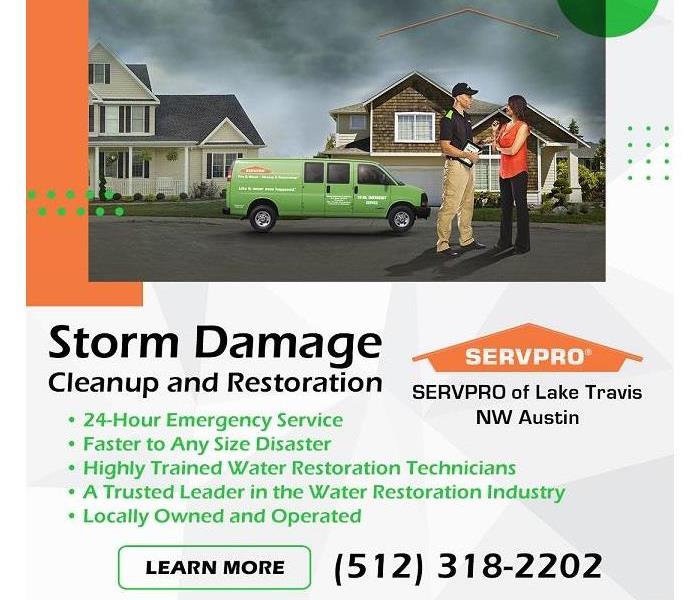 Here to Help
Here to Help
Summary: SERVPRO of Lake Travis/NW Austin explains the processes used to restore personal belongings damaged in a storm.
The team of professionals at SERVPRO of Lake Travis/NW Austin embraces the reality that a home is more than sheetrock and shingles or carpet and countertops. A family's clothing, keepsakes, heirlooms, furniture, and other belongings contribute to the transformation of a house into a home. When these belongings are damaged, the restoration team gives every item the attentive and gentle care it deserves.
Personal Belongings and Storm Damage
SERVPRO of Lake Travis/NW Austin specializes in contents restoration for belongings damaged in a storm, such as a tornado or water damage disaster. Clients save money and preserve invaluable, irreplaceable heirlooms due to SERVPRO's expertise and "restore" versus "replace" approach to damaged belongings. Damaged contents undergo a pretest screening to determine what items can be adequately restored to their pre-damage condition.
SERVPRO of Lake Travis/NW Austin employs several methods for cleaning contents, including dry cleaning, wet cleaning, spray and wipe, foam cleaning for delicate upholstery fabrics, abrasive cleaning, and immersion cleaning. The solutions used in these processes are safe for the items and the technicians.
Evacuating a Damaged Home: Move-Outs/Pack-Outs
When a home or business receives extensive damage and needs large-scale restoration or cleaning, SERVPRO of Lake Travis/NW Austin has the means to carry out an organized, efficient evacuation of the affected portion of the structure. Smaller, less equipped companies are not able to execute projects of this magnitude.
Emptying the home of most or all of its contents can accelerate the restoration and remodeling process. The construction and remodeling team has ample room to work without fear of damaging furniture or other household items. The contents are stored in a secure, dry area until the remodeling process is complete.
Upon completion, SERVPRO of Lake Travis/NW Austin works with the client to coordinate returning the contents according to the location. Insurance coverage may have a bearing on the moving services offered.
Electronic Cleanup
Electronic devices present a unique set of challenges and hazards when subjected to water damage. Electrical devices that show signs of exposure to moisture or are confirmed or suspected of having water damage should not be plugged into a receptacle or turned on for operation if they are battery operated. The experts at SERVPRO of Lake Travis/NW Austin can coordinate the restoration of electronics, including TVs, computers, and other electronics.
A successful restoration of an electronic device requires immediate action to prevent further water or moisture damage. The first step in the restoration process for electronics is to clean the outside of the device, which halts further damage such as corrosion. Clients can be confident their damaged electronics are well taken care of. Only a qualified electronics technician cleans and inspects damaged electronics. Smaller property damage restoration companies or cleaning companies that perform fire, water, and storm damage restoration as a secondary offering cannot provide large scale move-in/move-out service or the more technical electronics repair and restoration.
Document/Photograph Drying
Water-damaged documents such as photographs and old documents require extreme caution. Regrettably, some documents cannot be restored. SERVPRO of Lake Travis/ NW Austin can save many documents and help minimize additional damage using air-drying, dehumidification, freezer drying, vacuum freeze drying, and vacuum thermal drying.
Contents Claim Inventory Service
SERVPRO's Contents Claim Inventory Service (CCIS) provides a detailed, room-by-room, accurate inventory of a client's belongings, including digital images and, where called for, barcoding. The Contents Claim Inventory Service is comprehensive and includes a preloss list and valuation of contents, as well as a detailed and accurate report. The service provides better information that allows for a quicker settlement of claims. The highly-trained SERVPRO professionals assist the client with the burden of proof for claims. The client enjoys peace of mind when they need it most.
A significant storm damage incident that impacts every facet of home life, including the most precious keepsakes, heirlooms, and photographs, can be emotionally distressing. Trusting storm damage restoration to the professionals at SERVPRO of Lake Travis/NW Austin is the right decision. The skilled, experienced, and certified technicians give tender care to keepsakes, heirlooms, and antiques that are more valuable than gold.
To learn more about how furniture, clothing, photos, important legal documents, artwork, and other personal belongings can be restored after fire, water, and storm damage, visit the SERVPRO of Lake Travis/NW Austin website at https://www.SERVPROlaketravisnwaustin.com. Contact the office by phone at (512) 318-2202.

 24/7 Emergency Service
24/7 Emergency Service




